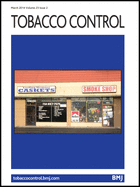Abstract:
Objective: Although portrayal of television (TV) and movie tobacco use has been linked with initiation of cigarette smoking in adolescents, its association with smoking in adults has not been assessed. Therefore, we examined long-term and annual changes in tobacco portrayal in popular US TV dramas and their associations with comparable trends in national adult cigarette consumption.
Methods: Tobacco use in 1838 h of popular US TV dramas was coded from 1955–2010. The long-term trend and annual deviations from trend were studied in relation to comparable trends in adult per capita cigarette consumption using correlational and time-series methods that controlled for other potential predictors.
Results: TV tobacco portrayal has trended downward since 1955 in line with the historical trend in cigarette consumption. Controlling for changes in cigarette prices and other factors, annual changes of one tobacco instance per episode hour across 2 years of programming were associated with annual change of 38.5 cigarettes per US adult. The decline in TV tobacco portrayal was associated with nearly half the effect of increases in cigarette prices over the study period.
Conclusions: The correlation between tobacco portrayal in TV dramas and adult cigarette consumption is consistent with well-established effects of exposure to tobacco cues that create craving for cigarettes in adult smokers. Although tobacco use in TV dramas along with movies has declined over time, portrayal of smoking on screen media should be a focus for future adult tobacco control research and policy.



